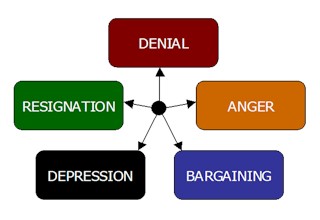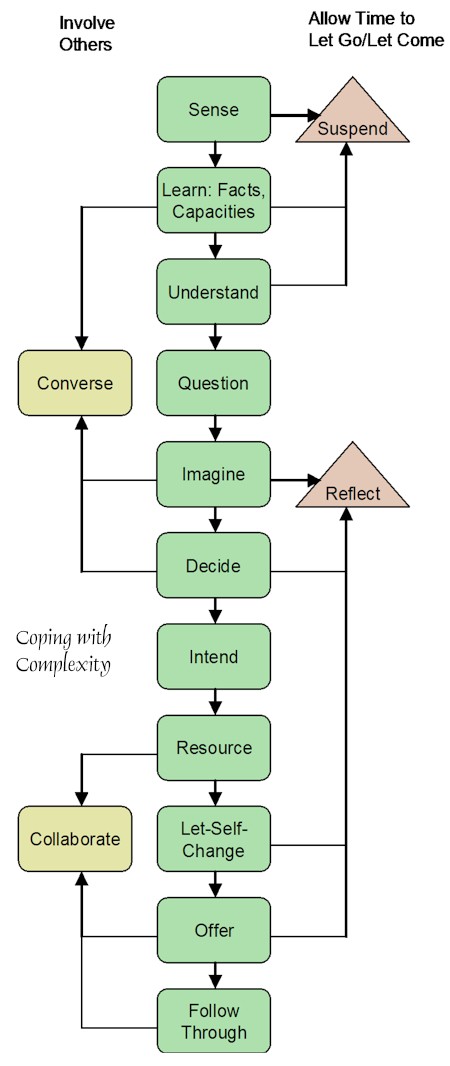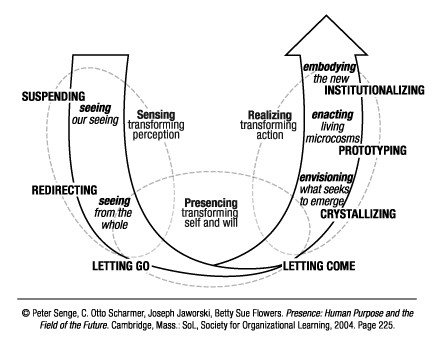 Yesterday I wrote about talking to children about death, and helping them cope with the news of the death of a loved one. A couple of readers said I should write about how adults can cope with bad news in general, and specifically, since this blog is often about environmental matters, how to cope with the relentless barrage of bad news about the environment. I’m learning to manage stress, including chronic stress, but horrific and unceasing waves of bad news are more than just stressful, they can, after a while, fill you with grief. And I wasn’t sure I could proffer any advice about this, since I’ve long struggled with my own sense of unbearable grief about Gaia. Grief, it seems to me, combines a feeling of great sadness or regret over loss with a feeling of helplessness to prevent its recurrence and/or hopelessness that we can ever be truly happy again because of it — not knowing how to cope with the sense that there was nothing we could have done to prevent this loss (or worse, that there was, and we didn’t do it). When you get the toxic cocktail of negative feelings — loss, helplessness, hopelessness and selg-loathing, it is hard to avoid reacting in inappropriate, unhealthy ways that reflect the stages of grief:
So what can we do to avoid reacting to relentless bad news in one of these six ways? Perhaps the best place to start is with an awareness of how our bodies are reacting, and an awareness of the emotions we are feeling. Our bodies react in visceral, instinctive, somatic ways that, over time, can actually cause severe and chronic physical illness. These physical, and our emotional, reactions to bad news are entirely natural, and we should not set ourselves the unreasonable objective of being able to ‘overcome’ them. For three million years the kind of ‘bad news’ we faced was the sudden presence of a predator who threatened to kill us or our loved ones. Our intuitive, largely subconscious reactions to such threats were very effective in generating the ‘fight or flight’ response that, in an evolutionary sense, was entirely appropriate and effective in mitigating that threat. These extreme reactions lasted only a short time, until the threat had passed. They were not chronic. But if the threat turned out to be lethal — a loved one was killed and eaten — then that effective ‘fight or flight’ response would become a debilitating traumatic response. Why would nature have endowed us to respond in this very negative, debilitating way to the loss of a loved one? Surely it could not convey any evolutionary advantage? Well, perhaps it could: Nothing leads us to appreciate life more than the realization of its fragile and temporary nature. “What doesn’t kill us makes us stronger”. We love the others who remain behind even more after such a loss, and protect them more. It is only when the loss leaves us utterly alone, with no one else we love remaining, that we tend to give up. In nature those in that situation are generally unhappy, vulnerable, and, of course, unable to procreate — so it may make sense for those left so alone to sacrifice themselves, to allow themselves to become food for those not so alone. That would be an effective evolutionary survival formula for the ecosystem as a whole. Of course, in modern human civilization, there is no such evolutionary advantage in such responses. But our civilization is simply too new to have allowed our bodies and emotions to adapt and manifest more appropriate responses to grief. And the firehose of modern communications allows us to feel that loss daily, so the trauma and grief become chronic. So one method of coping, I think, is to be aware of our emotions and how our bodies are reacting and to appreciate that this is an entirely natural, explicable response. Self-knowledge gives us back a bit of understanding and control, and that’s a good thing. Another important way of coping is learning to be more resilient so that when we do have these reactions we are able to recover from them more quickly and completely. The stress management techniques I’ve talked about in other articles — meditation, avoiding vexatious people, jobs and situations, self-hypnosis, a healthy, stimulant-free diet, exercise, healthy work habits, massage and physiotherapy, healthy sex, lots of social contact and social activities, generosity activities, play and fun, music, spending time in nature etc. can all help us prepare for bad news and be more resilient when it occurs. Perhaps another way of coping is to deliberately minimize our exposure to bad news that is not actionable. When there is something we can do about a bad news story — the modern equivalent of an immediate ‘fight or flight’ response — and when we do it, then the action usually has a cathartic benefit and our grief will likely be minimal. I’ve stopped reading most environmental news except for local stories, and even then I will only read about local environmental problems if I know I’m prepared to act to do something about them. The only other ways of coping I have found are social: Talking it out with sympathetic others so your grief isn’t bottled up inside. Keeping your sense of humour and exercising it with others at every opportunity. Learning something new, ideally with or from someone else. Accepting help from others and offering help to others. And, when you’re acting to do something about a local environmental or other problem, doing so with others. Being aware of and understanding our physical and emotional response to grief, building up our resilience, minimizing exposure to unactionable bad news, and engaging in lots of social coping activities — all of these can help mitigate the sorrow and damage that bad news can produce in our modern society. They can reduce its intensity and duration, but they won’t deaden us to it. And I think that’s a good thing. We can’t numb ourselves to pain without also numbing ourselves to joy. This is an incomplete solution, I know. What other techniques have you found that help you cope with regular, relentlesslybad news? And if you’re a believer in prayer then, as James Taylor says in his song Gaia, “For God’s sake say one for me — poor wretched unbeliever.” |
Navigation
Collapsniks
Albert Bates (US)
Andrew Nikiforuk (CA)
Brutus (US)
Carolyn Baker (US)*
Catherine Ingram (US)
Chris Hedges (US)
Dahr Jamail (US)
Dean Spillane-Walker (US)*
Derrick Jensen (US)
Dougald & Paul (IE/SE)*
Erik Michaels (US)
Gail Tverberg (US)
Guy McPherson (US)
Honest Sorcerer
Janaia & Robin (US)*
Jem Bendell (UK)
Mari Werner
Michael Dowd (US)*
Nate Hagens (US)
Paul Heft (US)*
Post Carbon Inst. (US)
Resilience (US)
Richard Heinberg (US)
Robert Jensen (US)
Roy Scranton (US)
Sam Mitchell (US)
Tim Morgan (UK)
Tim Watkins (UK)
Umair Haque (UK)
William Rees (CA)
XrayMike (AU)
Radical Non-Duality
Tony Parsons
Jim Newman
Tim Cliss
Andreas Müller
Kenneth Madden
Emerson Lim
Nancy Neithercut
Rosemarijn Roes
Frank McCaughey
Clare Cherikoff
Ere Parek, Izzy Cloke, Zabi AmaniEssential Reading
Archive by Category
My Bio, Contact Info, Signature Posts
About the Author (2023)
My Circles
E-mail me
--- My Best 200 Posts, 2003-22 by category, from newest to oldest ---
Collapse Watch:
Hope — On the Balance of Probabilities
The Caste War for the Dregs
Recuperation, Accommodation, Resilience
How Do We Teach the Critical Skills
Collapse Not Apocalypse
Effective Activism
'Making Sense of the World' Reading List
Notes From the Rising Dark
What is Exponential Decay
Collapse: Slowly Then Suddenly
Slouching Towards Bethlehem
Making Sense of Who We Are
What Would Net-Zero Emissions Look Like?
Post Collapse with Michael Dowd (video)
Why Economic Collapse Will Precede Climate Collapse
Being Adaptable: A Reminder List
A Culture of Fear
What Will It Take?
A Future Without Us
Dean Walker Interview (video)
The Mushroom at the End of the World
What Would It Take To Live Sustainably?
The New Political Map (Poster)
Beyond Belief
Complexity and Collapse
Requiem for a Species
Civilization Disease
What a Desolated Earth Looks Like
If We Had a Better Story...
Giving Up on Environmentalism
The Hard Part is Finding People Who Care
Going Vegan
The Dark & Gathering Sameness of the World
The End of Philosophy
A Short History of Progress
The Boiling Frog
Our Culture / Ourselves:
A CoVid-19 Recap
What It Means to be Human
A Culture Built on Wrong Models
Understanding Conservatives
Our Unique Capacity for Hatred
Not Meant to Govern Each Other
The Humanist Trap
Credulous
Amazing What People Get Used To
My Reluctant Misanthropy
The Dawn of Everything
Species Shame
Why Misinformation Doesn't Work
The Lab-Leak Hypothesis
The Right to Die
CoVid-19: Go for Zero
Pollard's Laws
On Caste
The Process of Self-Organization
The Tragic Spread of Misinformation
A Better Way to Work
The Needs of the Moment
Ask Yourself This
What to Believe Now?
Rogue Primate
Conversation & Silence
The Language of Our Eyes
True Story
May I Ask a Question?
Cultural Acedia: When We Can No Longer Care
Useless Advice
Several Short Sentences About Learning
Why I Don't Want to Hear Your Story
A Harvest of Myths
The Qualities of a Great Story
The Trouble With Stories
A Model of Identity & Community
Not Ready to Do What's Needed
A Culture of Dependence
So What's Next
Ten Things to Do When You're Feeling Hopeless
No Use to the World Broken
Living in Another World
Does Language Restrict What We Can Think?
The Value of Conversation Manifesto Nobody Knows Anything
If I Only Had 37 Days
The Only Life We Know
A Long Way Down
No Noble Savages
Figments of Reality
Too Far Ahead
Learning From Nature
The Rogue Animal
How the World Really Works:
Making Sense of Scents
An Age of Wonder
The Truth About Ukraine
Navigating Complexity
The Supply Chain Problem
The Promise of Dialogue
Too Dumb to Take Care of Ourselves
Extinction Capitalism
Homeless
Republicans Slide Into Fascism
All the Things I Was Wrong About
Several Short Sentences About Sharks
How Change Happens
What's the Best Possible Outcome?
The Perpetual Growth Machine
We Make Zero
How Long We've Been Around (graphic)
If You Wanted to Sabotage the Elections
Collective Intelligence & Complexity
Ten Things I Wish I'd Learned Earlier
The Problem With Systems
Against Hope (Video)
The Admission of Necessary Ignorance
Several Short Sentences About Jellyfish
Loren Eiseley, in Verse
A Synopsis of 'Finding the Sweet Spot'
Learning from Indigenous Cultures
The Gift Economy
The Job of the Media
The Wal-Mart Dilemma
The Illusion of the Separate Self, and Free Will:
No Free Will, No Freedom
The Other Side of 'No Me'
This Body Takes Me For a Walk
The Only One Who Really Knew Me
No Free Will — Fightin' Words
The Paradox of the Self
A Radical Non-Duality FAQ
What We Think We Know
Bark Bark Bark Bark Bark Bark Bark
Healing From Ourselves
The Entanglement Hypothesis
Nothing Needs to Happen
Nothing to Say About This
What I Wanted to Believe
A Continuous Reassemblage of Meaning
No Choice But to Misbehave
What's Apparently Happening
A Different Kind of Animal
Happy Now?
This Creature
Did Early Humans Have Selves?
Nothing On Offer Here
Even Simpler and More Hopeless Than That
Glimpses
How Our Bodies Sense the World
Fragments
What Happens in Vagus
We Have No Choice
Never Comfortable in the Skin of Self
Letting Go of the Story of Me
All There Is, Is This
A Theory of No Mind
Creative Works:
Mindful Wanderings (Reflections) (Archive)
A Prayer to No One
Frogs' Hollow (Short Story)
We Do What We Do (Poem)
Negative Assertions (Poem)
Reminder (Short Story)
A Canadian Sorry (Satire)
Under No Illusions (Short Story)
The Ever-Stranger (Poem)
The Fortune Teller (Short Story)
Non-Duality Dude (Play)
Your Self: An Owner's Manual (Satire)
All the Things I Thought I Knew (Short Story)
On the Shoulders of Giants (Short Story)
Improv (Poem)
Calling the Cage Freedom (Short Story)
Rune (Poem)
Only This (Poem)
The Other Extinction (Short Story)
Invisible (Poem)
Disruption (Short Story)
A Thought-Less Experiment (Poem)
Speaking Grosbeak (Short Story)
The Only Way There (Short Story)
The Wild Man (Short Story)
Flywheel (Short Story)
The Opposite of Presence (Satire)
How to Make Love Last (Poem)
The Horses' Bodies (Poem)
Enough (Lament)
Distracted (Short Story)
Worse, Still (Poem)
Conjurer (Satire)
A Conversation (Short Story)
Farewell to Albion (Poem)
My Other Sites

 At a time of great distress and grief, the thought of having to speak to children about the loss of a loved one can bring on an unbearable additional anxiety. We no longer live in a world where children frequently witness death as a part of life, and so it is hard for them to grapple with, and hard on us to try to figure out how best to break such tragic news to them and help them through their own, unique stress and grief. They go through the same
At a time of great distress and grief, the thought of having to speak to children about the loss of a loved one can bring on an unbearable additional anxiety. We no longer live in a world where children frequently witness death as a part of life, and so it is hard for them to grapple with, and hard on us to try to figure out how best to break such tragic news to them and help them through their own, unique stress and grief. They go through the same 





 The second occurred in Indonesia, where reckless seismic testing for natural gas has destabilized underground faults and produced
The second occurred in Indonesia, where reckless seismic testing for natural gas has destabilized underground faults and produced 






